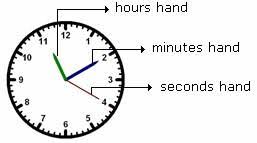Quantitative Aptitude :: Clock
Clock Important Formulas
 Have you seen clock dial and thought ever that there could be some tricky question hidden in its hours, Minutes, and Seconds hand. In every exams whether it will be IT companies written-round exams (TCS, Capgemini, Wipro, CTS, Infosys, IBM, TCS Ninja, TCS NQT, etc.) or any competitive exams (AMCAT, Cocubes, Elitmus, SSC, CAT, XAT, MAT, GRE, GMAT, etc.) question papers have at least 1 or 2 questions from this topic.
Have you seen clock dial and thought ever that there could be some tricky question hidden in its hours, Minutes, and Seconds hand. In every exams whether it will be IT companies written-round exams (TCS, Capgemini, Wipro, CTS, Infosys, IBM, TCS Ninja, TCS NQT, etc.) or any competitive exams (AMCAT, Cocubes, Elitmus, SSC, CAT, XAT, MAT, GRE, GMAT, etc.) question papers have at least 1 or 2 questions from this topic.
A small practice and clear understanding about its hour & minute hand and angle formation by both hands make you expert in solving questions based on it. Clock arithmetic aptitude section covers important formulas & Tricks, subjective questions covering each type of question, MCQs and at last quiz is included, which help you to track your preparation.
Note: It is recommended to keep your preparation in sequence (Important formulas -> Subjective Question -> Solve MCQs -> Take Quiz based on clock)
Do you know? Clock dial looks like a complete circle that divided into 12 equal parts, and it's every division represent different hours of the day. Each hour space is further subdivided into 5 spaces – this represents a duration of 1 minute. There are typically 2 hands that rotate in a clock. Though in totality there are three hands, but the seconds hand is not that significant from the point of view of clocks aptitude questions.
The face or dial of watch is a circle whose circumference is divided into 60 equal parts, called Minute Spaces.
A clock has two hands, the smaller one is called the hour hand or short hand while the larger one is called minute hand or long hand.
> As minute hand covers one full circle i.e. 360 degrees in one hour, that means it travels \(\frac{360}{60}\) = 6 degrees/min.
> An hour hand covers one part of the 12 major parts of the circle which means it covers \(\frac{360}{12}\) = 30 degrees in one hour i.e. it travels \(\frac{30}{60}\) = \(\frac{1}{2}\) degree per min.
> So, the relative speed of the minute hand will be \(\left(6 – \frac{1}{2}\right)\) = \(\left(\frac{11}{2}\right)\)° or 5.5°.
> Note: This \(\left(\frac{11}{2}\right)\)° can be used to find the angle between the two hands of the clock.
> In 60 minutes, the minute hand gains 55 minutes on the hour hand
> In every hour, both the hands coincide once. But in a 12 hour period, they meet 11 times.
> The hands are in the same straight line when they are coincident or opposite to each other.
> There is one angle of 180 degrees in every hour i.e. both the hands are in the straight line in the opposite direction, but in a twelve-hour period, it happens 11 times.
> When the two hands are at right angles, they are 15 minute spaces apart.
> There are 2 right angles every hour, but in a 12 hour period, there are 22 such angles.
> When the hands are in opposite directions, they are 30 minute spaces apart.
> If the two hands are moving at the normal speeds, they should meet after every \(65\frac{5}{11}\) min.
> Angle traced by hour hand in 12 hrs = 360°
> Angle traced by minute hand in 60 min. = 360°.
Too Fast and Too Slow:
If a watch or a clock indicates 8.15, when the correct time is 8, it is said to be 15 minutes too fast.
On the other hand, if it indicates 7.45, when the correct time is 8, it is said to be 15 minutes too slow.

